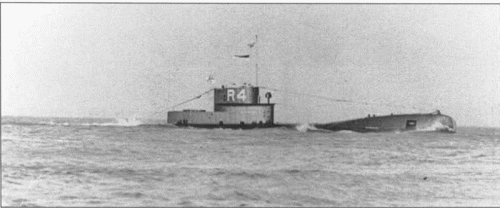
NAVYPEDIA
 Support the project with paypal
Support the project with paypal
Photo

R4
Ships
| Name | No | Yard No | Builder | Laid down | Launched | Comp | Fate |
|---|---|---|---|---|---|---|---|
| R1 | Chatham DYd | 2/1917 | 25.4.1918 | 10/1918 | sold 1.1923 | ||
| R2 | Chatham DYd | 2/1917 | 25.4.1918 | 12/1918 | sold 2.1923 | ||
| R3 | Chatham DYd | 2/1917 | 8.6.1918 | 3/1919 | sold 2.1923 | ||
| R4 | Chatham DYd | 2.1917 | 8.6.1918 | 8/1919 | sold 5.1934 | ||
| R5 | Pembroke DYd | 1917 | --- | --- | cancelled 1919 | ||
| R6 | Pembroke DYd | 1917 | --- | --- | cancelled 1919 | ||
| R7 | Vickers, Barrow | 11/1917 | 14.5.1918 | 6/1918 | sold 2.1923 | ||
| R8 | Vickers, Barrow | 11/1917 | 28.6.1918 | 7.1918 | sold 2.1923 | ||
| R9 | Armstrong, Elswick | 12/1917 | 12.8.1918 | 10.1918 | sold 2.1923 | ||
| R10 | Armstrong, Elswick | 12/1917 | 5.10.1918 | 4/1919 | sold 2.1929 | ||
| R11 | Cammell Laird, Birkenhead | 12/1917 | 16.3.1918 | 8/1918 | sold 2.1923 | ||
| R12 | Cammell Laird, Birkenhead |
12/1917 | 9.4.1918 | 10/1918 | sold 2.1923 |
Technical data
| ` | 6 - 450 TT (bow, 12) |
|---|---|
| Displacement standard, t | |
| Displacement normal, t | 410 / 503 |
| Length, m | 49.9 |
| Breadth, m | 4.65 |
| Draught, m | 3.51 |
| No of shafts | 1 |
| Machinery | 1 NLSE diesel / 2 electric motors / 1 electric motor for slow running |
| Power, h. p. | 240 / 1200 / 25 |
| Max speed, kts | 9.5 / 15 |
| Fuel, t | diesel oil 13 |
| Endurance, nm(kts) | 2000(8) / 240(4) |
| Complement | 22 |
| Diving depth operational, m | 75 |
Standard scale images

R1 1918
Graphics
Project history
This class, the first anti-submarine 'hunter-killers', were 30 years ahead of their time. In March 1917 the DNC's department submitted a design of submarine fast enough to overtake enemy submarines and sink them with torpedoes, rather than gunfire. The design was not approved, but later that year when Commodore (S) suggested the idea should be developed, it was resurrected and orders were placed in December (armament increased from four to six TT). The hull reverted to the 'spindle' shape of the 'Hollands' and 'A' to 'C classes, and hull-sections were the same as the H21 class to save time (they were ordered in place of cancelled 'H' boats). The propulsion unit was a single 'H' engine, but a 'J' class 220-cell battery was used to boost underwater speed. An unusual step was the provision of a small 25hp auxiliary motor mounted on the shaft, for slow running. The bow compartment contained five powerful and sensitive hydrophones, with bearing measurement lo allow torpedoes to be fired underwater. Although the single shaft made them hard to manoeuvre on the surface, the streamlined hull and large rudder gave them good underwater performance. Unfortunately the only engagement in which their unique capabilities could be used - R8's October 1918 attack on a U-boat - was marred by a faulty torpedo, and they were discarded early.
Modernizations
None
Naval service
No significant events.
 HOME
HOME FIGHTING SHIPS OF THE WORLD
FIGHTING SHIPS OF THE WORLD UNITED KINGDOM
UNITED KINGDOM SUBMARINES
SUBMARINES "R" submarines (R1) (10(2), 1918 - 1919)
"R" submarines (R1) (10(2), 1918 - 1919)
